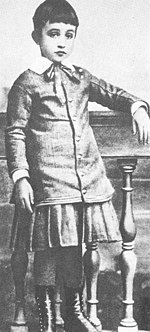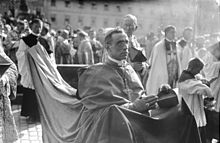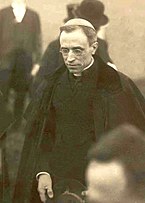
Pope Pius XII (Italian: Pio XII), born Eugenio Maria Giuseppe Giovanni Pacelli[a] (Italian pronunciation: [euˈdʒɛnjo maˈria dʒuˈzɛppe dʒoˈvanni paˈtʃɛlli]; 2 March 1876 – 9 October 1958), reigned from 2 March 1939 to his death in 1958. Before his election to the papacy, Pacelli served as secretary of the Department of Extraordinary Ecclesiastical Affairs, papal nuncio to Germany (1917–1929), and Cardinal Secretary of State, in which capacity he worked to conclude treaties with European and Latin American nations, most notably the Reichskonkordat with Nazi Germany, with which most historians believe the Vatican sought to protect the Church in Germany while Adolf Hitler sought the destruction of "political Catholicism".[1]
A pre-war critic of Nazism, Pius XII lobbied world leaders to avoid war and, as Pope at the outbreak of war, issued Summi Pontificatus, expressing dismay at the invasion of Poland, reiterating Church teaching against racial persecution and calling for love, compassion and charity to prevail over war.[2]
While the Vatican was officially neutral during the war, Pius XII maintained links to the German Resistance, used diplomacy to aid the victims of the war and lobby for peace and spoke out against race-based murders and other atrocities.[3] The Reichskonkordat of 1933 and Pius's leadership of the Catholic Church during World War II remain the subject of controversy—including allegations of public silence and inaction about the fate of the Jews.[4] After the war Pius XII advocated peace and reconciliation, including lenient policies towards Axis and Axis-satellite nations. The Church experienced severe persecution and mass deportations of Catholic clergy in the Eastern Bloc. Pius XII was a staunch opponent of Communism and of the Italian Communist Party. Pius XII explicitly invoked ex cathedra papal infallibility with the dogma of the Assumption of Mary in his 1950 Apostolic constitution Munificentissimus Deus.[5] His magisterium includes almost 1,000 addresses and radio broadcasts. His forty-one encyclicals include Mystici corporis, the Church as the Body of Christ; Mediator Dei on liturgy reform; and Humani generis on the Church's positions on theology and evolution. He eliminated the Italian majority in the College of Cardinals in 1946.
Pius XII suffered from the shadow of ill health in 1954 which would continue until his death in 1958. The embalming of his body was mishandled, with effects that were evident during the funeral. He was buried in the Vatican grottos and was succeeded by Pope John XXIII.
In the process toward sainthood, his cause for canonization was opened on 18 November 1965 by Pope Paul VI during the final session of the Second Vatican Council. He was made a Servant of God by Pope John Paul II in 1990 and Pope Benedict XVI declared Pius XII Venerable on 19 December 2009.[6]
Early life
Main article: Early life of Pope Pius XII
Eugenio Maria Giuseppe Giovanni Pacelli was born on 2 March 1876 in
Rome into a family of intense Catholic piety with a history of ties to
the papacy (the "Black Nobility").
His parents were Filippo Pacelli (1837–1916) and Virginia (née
Graziosi) Pacelli (1844–1920). His grandfather, Marcantonio Pacelli, had
been Under-Secretary in the Papal Ministry of Finances[7] and then Secretary of the Interior under Pope Pius IX from 1851–70 and helped found the Vatican's newspaper, L'Osservatore Romano in 1861.[8][9] His cousin, Ernesto Pacelli, was a key financial advisor to Pope Leo XIII; his father, Filippo Pacelli, a Franciscan tertiary,[10] was the dean of the Sacra Rota Romana; and his brother, Francesco Pacelli, became a lay canon lawyer and the legal advisor to Pius XI, in which role he negotiated the Lateran Treaty in 1929, the pact with Benito Mussolini, bringing an end to the Roman Question.
Eugenio Pacelli at the age of six in 1882
In 1894, aged 18, Pacelli began his theology studies at Rome's oldest seminary, the Almo Collegio Capranica,[12] and in November of the same year, registered to take a philosophy course at the Jesuit Pontifical Gregorian University and theology at the Pontifical Roman Athenaeum S. Apollinare. He was also enrolled at the State University, La Sapienza where he studied modern languages and history. At the end of the first academic year however, in the summer of 1895, he dropped out of both the Capranica and the Gregorian University. According to his sister Elisabetta, the food at the Capranica was to blame.[13] Having received a special dispensation he continued his studies from home and so spent most of his seminary years as an external student. In 1899 he completed his education in Sacred Theology with a doctoral degree awarded on the basis of a short dissertation and an oral examination in Latin.[14]
Church career
Priest and Monsignor
Pacelli on the day of his ordination, 2 April 1899.
Monsignor Pietro Gasparri, the recently appointed undersecretary at the Department of Extraordinary Affairs, had underscored his proposal to Pacelli to work in the 'Vatican's equivalent of the Foreign office' by highlighting the 'necessity of defending the Church from the onslaughts of secularism and liberalism throughout Europe.'[18] Pacelli became an apprendista, an apprentice, in Gasparri's department. In January 1901 he was also chosen, by Pope Leo XIII himself, according to an official account, to deliver condolences on behalf of the Vatican to King Edward VII of the UK after the death of Queen Victoria.[19]
The Serbian Concordat, 24 June 1914. Present for the Vatican were Cardinal Merry del Val and next to him, Pacelli.
In 1908, Pacelli served as a Vatican representative on the International Eucharistic Congress, accompanying Rafael Merry del Val[22] to London,[19] where he met Winston Churchill.[23] In 1911, he represented the Holy See at the coronation of King George V.[20] Pacelli became the under-secretary in 1911, adjunct-secretary in 1912 (a position he received under Pope Pius X and retained under Pope Benedict XV), and secretary of the Department of Extraordinary Ecclesiastical Affairs in February 1914.[20] On 24 June 1914, just four days before Archduke Franz Ferdinand of Austria was assassinated in Sarajevo, Pacelli, together with Cardinal Merry del Val, represented the Vatican when the Serbian Concordat was signed. Serbia's success in the First Balkan War against Turkey in 1912 had increased the number of Catholics within greater Serbia. At this time Serbia, encouraged by Russia, was challenging Austria-Hungary's sphere of influence throughout the Balkans. Pius X died on 20 August 1914. His successor Benedict XV named Gasparri as secretary of state and Gasparri took Pacelli with him into the Secretariat of State, making him undersecretary.[24] During World War I, Pacelli maintained the Vatican's registry of prisoners of war and worked to implement papal relief initiatives. In 1915, he travelled to Vienna to assist Monsignor Raffaele Scapinelli, nuncio to Vienna, in his negotiations with Emperor Franz Joseph I of Austria regarding Italy.[25]
Archbishop and Papal Nuncio
Main article: Nunciature of Eugenio Pacelli
Pacelli at the Headquarters of Wilhelm II
Once in Munich, he conveyed the papal initiative to end the war to German authorities.[26] He met with King Ludwig III on 29 May, and later with Kaiser Wilhelm II[27] and Chancellor Bethmann-Hollweg, who replied positively to the Papal initiative. However, Bethmann-Hollweg was forced to resign and the German High Command, hoping for a military victory, delayed the German reply until 20 September.
Sister Pascalina later recalled that the Nuncio was heartbroken that the Kaiser turned "deaf ear to all his proposals". She later wrote, "Thinking back today on that time, when we Germans still all believed that our weapons would be victorious and the Nuncio was deeply sorry that the chance had been missed to save what there was to save, it occurs to me over and over again how clearly he foresaw what was to come. Once as he traced the course of the Rhine with his finger on a map, he said sadly, 'No doubt this will be lost as well.' I did not want to believe it, but here, too, he was to be proved right."[28]
For the remainder of the Great War, Pacelli concentrated on Benedict's humanitarian efforts[29] especially among Allied POWs in German custody.[30] In the upheaval following the Armistice, a disconcerted Pacelli sought Benedict XV's permission to leave Munich, where Kurt Eisner had formed the Bavarian Soviet Republic, and he left for a while to Rorschach, and a tranquil Swiss sanatorium run by nuns. Monsignor Schioppa, the uditore, was left in Munich.[31]
"His recovery began with a 'rapport'" with the 24-year-old Sister Pascalina Lehnert—she would soon be transferred to Munich when Pacelli "pulled strings at the highest level".[32]
When he returned to Munich, following Eisner's assassination by an anti-Semitic extreme nationalist, Count Anton von Arco auf Valley, he informed Gasparri-using Schioppa's eye-witness testimony of the chaotic scene at the former royal palace as the trio of Max Levien, Eugen Levine, and Towia Axelrod sought power: "the scene was indescribable [-] the confusion totally chaotic [-] in the midst of all this, a gang of young women, of dubious appearance, Jews like the rest of them hanging around [-] the boss of this female rabble was Levien's mistress, a young Russian woman, a Jew and a divorcée [-] and it was to her that the nunciature was obliged to pay homage in order to proceed [-] Levien is a young man, also Russian and a Jew. Pale, dirty, with drugged eyes, vulgar, repulsive ..." John Cornwell alleges that a worrying impression of anti-Semitism is discernible in the 'catalogue of epithets describing their physical and moral repulsiveness' and Pacelli's "constant harping on the Jewishness of this party of power usurpers" chimed with the "growing and widespread belief among Germans that the Jews were the instigators of the Bolshevik revolution, their principal aim being the destruction of Christian civilization".[33] Also according to Cornwell, Pacelli informed Gasparri that "the capital of Bavaria, is suffering under a harsh Jewish-Russian revolutionary tyranny"[34]
According to Sister Pascalina Lehnert, the Nuncio was repeatedly threatened by emissaries of the Bavarian Soviet Republic. Once, in a violation of international law, the Bavarian Revolutionary Government attempted to confiscate the Nunciature's car at gunpoint. Despite their demands, however, Pacelli refused to leave his post.[35]
After the Munich Soviet Republic defeated and toppled by Freikorps and Reichswehr troops, the Nuncio focused on, according to Lehnert, "alleviating the distress of the postwar period, consoling, supporting all in word and deed."[36]
Nuncio Pacelli in July 1924 at the 900th anniversary of the City of Bamberg
Pacelli in Bavaria, 1922.
Despite Vatican pessimism and a lack of visible progress, Pacelli continued the secret negotiations, until Pius XI ordered them to be discontinued in 1927. Pacelli supported German diplomatic activity aimed at rejection of punitive measures from victorious former enemies. He blocked French attempts for an ecclesiastical separation of the Saar region, supported the appointment of a papal administrator for Danzig and aided the reintegration of priests expelled from Poland.[40] A Prussian Concordat was signed on 14 June 1929. Following the Wall Street Crash of 1929, the beginnings of a world economic slump appeared, and the days of the Weimar Republic were numbered. Pacelli was summoned back to Rome at this time—the call coming by telegram when he was resting at his favourite retreat, the Rorschach convent sanatorium. He left Berlin on 10 December 1929.[41] David Dalin wrote "of the forty-four speeches Pacelli gave in Germany as papal nuncio between 1917 and 1929, forty denounced some aspect of the emerging Nazi ideology."[42] In 1935 he wrote a letter to the bishop of Cologne describing the Nazis as "false prophets with the pride of Lucifer." and as "bearers of a new faith and a new Evangile" who were attempting to create "a mendacious antimony between faithfulness to the Church and the Fatherland".[43] Two years later at Notre Dame in Paris he named Germany as "that noble and powerful nation whom bad shepherds would lead astray into an ideology of race."[42]






